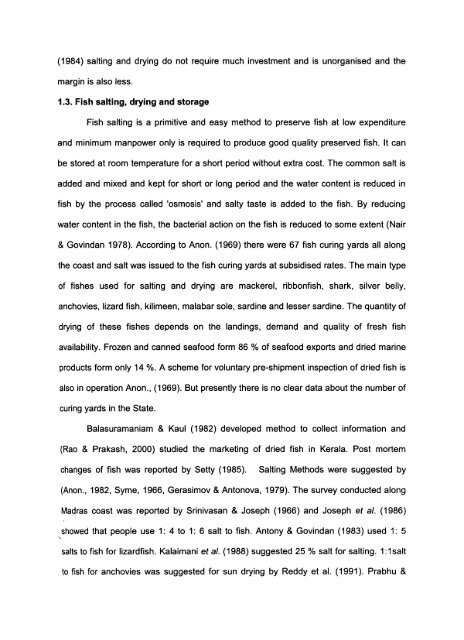Studies on the Quality and Process Control Factors During the ...
Studies on the Quality and Process Control Factors During the ...
Studies on the Quality and Process Control Factors During the ...
You also want an ePaper? Increase the reach of your titles
YUMPU automatically turns print PDFs into web optimized ePapers that Google loves.
(1984) salting <strong>and</strong> drying do not require much investment <strong>and</strong> is unorganised <strong>and</strong> <strong>the</strong><br />
margin is also less.<br />
1.3. Fish salting, drying <strong>and</strong> storage<br />
Fish salting is a primitive <strong>and</strong> easy method to preserve fish at low expenditure<br />
<strong>and</strong> minimum manpower <strong>on</strong>ly is required to produce good quality preserved fish. It can<br />
be stored at room temperature for a short period without extra cost. The comm<strong>on</strong> salt is<br />
added <strong>and</strong> mixed <strong>and</strong> kept for short or l<strong>on</strong>g period <strong>and</strong> <strong>the</strong> water c<strong>on</strong>tent is reduced in<br />
fish by <strong>the</strong> process called 'osmosis' <strong>and</strong> salty taste is added to <strong>the</strong> fish. By reducing<br />
water c<strong>on</strong>tent in <strong>the</strong> fish, <strong>the</strong> bacterial acti<strong>on</strong> <strong>on</strong> <strong>the</strong> fish is reduced to some extent (Nair<br />
& Govindan 1978). According to An<strong>on</strong>. (1969) <strong>the</strong>re were 67 fish curing yards all al<strong>on</strong>g<br />
<strong>the</strong> coast <strong>and</strong> salt was issued to <strong>the</strong> fish curing yards at subsidised rates. The main type<br />
of fishes used for salting <strong>and</strong> drying are mackerel, ribb<strong>on</strong>fish, shark, silver belly,<br />
anchovies, lizard fish, kilimeen, malabar sole, sardine <strong>and</strong> lesser sardine. The quantity of<br />
drying of <strong>the</strong>se fishes depends <strong>on</strong> <strong>the</strong> l<strong>and</strong>ings, dem<strong>and</strong> <strong>and</strong> quality of fresh fish<br />
availability. Frozen <strong>and</strong> canned seafood form 86 % of seafood exports <strong>and</strong> dried marine<br />
products form <strong>on</strong>ly 14 %. A scheme for voluntary pre-shipment inspecti<strong>on</strong> of dried fish is<br />
also in operati<strong>on</strong> An<strong>on</strong>., (1969). But presently <strong>the</strong>re is no clear data about <strong>the</strong> number of<br />
curing yards in <strong>the</strong> State.<br />
Balasuramaniam & Kaul (1982) developed method to collect informati<strong>on</strong> <strong>and</strong><br />
(Rao & Prakash, 2000) studied <strong>the</strong> marketing of dried fish in Kerala. Post mortem<br />
changes of fish was reported by Setty (1985). Salting Methods were suggested by<br />
(An<strong>on</strong>., 1982, Syme, 1966, Gerasimov & Ant<strong>on</strong>ova, 1979). The survey c<strong>on</strong>ducted al<strong>on</strong>g<br />
Madras coast was reported by Srinivasan & Joseph (1966) <strong>and</strong> Joseph et al. (1986)<br />
showed that people use 1: 4 to 1: 6 salt to fish. Ant<strong>on</strong>y & Govindan (1983) used 1: 5<br />
\.<br />
salts to fish for lizardfish. Kalaimani et al. (1988) suggested 25 % salt for salting. 1 :1salt<br />
to fish for anchovies was suggested for sun drying by Reddy et al. (1991). Prabhu &

















